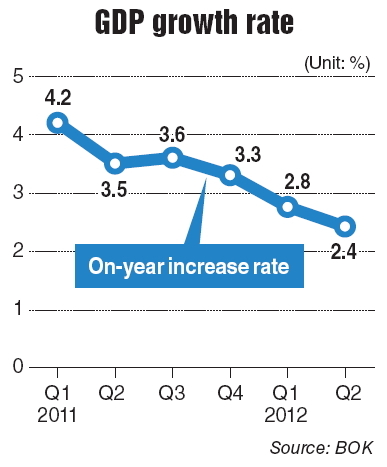Chances of annual growth below 3% higher, experts say
Korea’s second-quarter growth more than halved from the preceding three months as the eurozone debt crisis dampened exports, raising concerns that the country’s annual growth might fall under 3 percent.
The fourth-largest economy in Asia grew 0.4 percent on-quarter in the April-June period, slowing from a 0.9 percent in the first quarter, the Bank of Korea said Thursday.
“The growth of consumer spending slowed while facility investment and exports contracted in the second quarter,” the central bank said in a statement.
Korea’s exports dropped 0.6 percent on-quarter in the second quarter after gaining 3 percent three months earlier, according to the BOK.

Private spending grew 0.5 percent, slowing from 1 percent in the previous quarter.
Facility investment shrank 6.4 percent after growing 10.3 percent in the first quarter, and construction investment grew 0.3 percent after falling 1.2 percent in the preceding quarter.
Korea’s gross domestic product grew 2.4 percent in the second quarter from a year earlier, marking the slowest on-year growth in 33 months.
The dismal growth heightened fears that the country’s economy might grow less than 3 percent this year, prompting local brokerages to lower their forecasts.
Samsung Securities’ macroeconomist Huh Jin-wook said his company was set to lower its annual growth forecast from 3.1 percent.
“In order to reach an annual growth of 3 percent, exports in the second half have to be better than the first half,” Huh said.
“But with situations in Italy and Spain getting worse, economic conditions in Europe, the U.S. and emerging economies are expected to deteriorate in the second half, which means exports won’t pick up.”
Huh said chances of a 2-percent-range annual growth are high unless the Korean government unveils a stimulus package.
Lim Dong-min, an economist at KB Investment & Securities, also said Korea’s growth depends on the recovery of global demands, which seems unlikely at the moment.
“To reach an annual growth of 3 percent, quarterly growth rates in the second half have to be around 1 percent each, which appears to be difficult if you look at the growth figures over the last three quarters,” Lim said.
The country’s quarterly growth fell to 0.3 percent in the fourth quarter of last year, the lowest in two years, and rose to 0.9 percent in the first quarter of this year. The average on-quarter growth between 2000 and the second quarter of 2008 was around 1.2 percent.
Korea’s annual GDP growth fell below 3 percent five times in the past four decades since the BOK started announcing the figures.
In that time the country’s economy saw its first negative growth of -1.9 percent in 1980, the lowest rate of -5.7 percent in 1998 amid the Asian financial crisis, 2.8 percent in 2003 in the wake of the credit card debacle, and 2.3 percent in 2008 and 0.3 percent in 2009 due to the global financial crisis.
Economists attribute the sluggish growth mainly to the eurozone debt crisis, which recently took another turn for worse with the rising possibility of Spain asking for an international bailout like Greece, Ireland or Portugal.
Economic conditions in China, Korea’s largest export destination, aren’t promising either. China’s second-quarter growth fell below eight percent for the first time in three years to 7.6 percent on-year.
Hyundai Research Institute said in a recent report that for every 1 percentage point drop in China’s economic growth, Korea’s growth would fall by 0.4 percentage point.
The International Monetary Fund lowered its annual growth projection for the U.S. early this month by a percentage point to 2 percent.
By Kim So-hyun (
sophie@heraldcorp.com)







![[Weekender] Korea's traditional sauce culture gains global recognition](http://res.heraldm.com/phpwas/restmb_idxmake.php?idx=644&simg=/content/image/2024/11/21/20241121050153_0.jpg)
